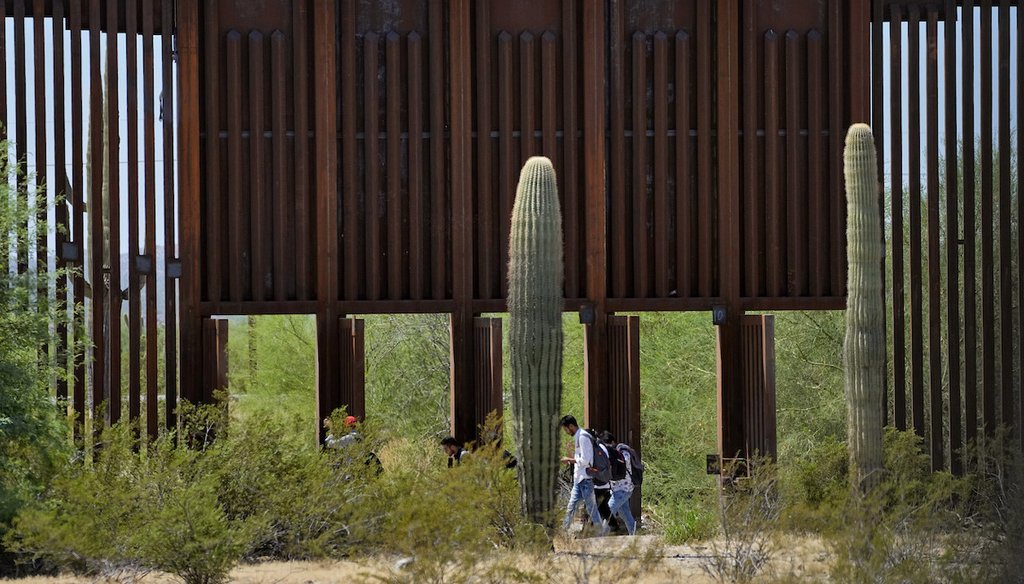Stand up for the facts!
Our only agenda is to publish the truth so you can be an informed participant in democracy.
We need your help.
I would like to contribute

A group claiming to be from India walk past open border wall storm gates after crossing through the border fence in the Tucson Sector of the U.S.-Mexico border, Aug. 29, 2023, in Organ Pipe Cactus National Monument near Lukeville, Ariz. (AP)
If Your Time is short
-
In Arizona, gates along the southern border are open during the summer monsoon season to prevent flooding from knocking the fencing down. Arizona’s monsoon season runs from mid-June to the end of September.
-
This practice began under former President Donald Trump’s administration because the fencelike barrier design accumulates debris.
-
Immigrants who reach border barriers are already on U.S. soil and are subject to immigration laws.
President Joe Biden’s critics are claiming on social media that there is video and photo evidence that he has an "open borders" policy.
Sen. Ted Cruz, R-Texas, on X, formerly Twitter, shared a post that said "the Biden administration welded open the Trump border wall in Tucson, AZ. It’s not a crisis. It’s by design."
This…is…nuts.#BidenBorderCrisis https://t.co/aRcWYL7XW2
— Ted Cruz (@tedcruz) August 28, 2023
On his show Aug. 22, Fox News host Jesse Watters also said Biden is "opening gaping holes" across the border "so migrants can march through."
"The door to America is wide open," said an Aug. 21 story from the New York Post. The article said that border officials "inexplicably welded open 114 massive gates along the Arizona border" and are allowing thousands of migrants to "casually walk into the country."
But what these claims ignore is that these stormwater gates are propped open so sections of the border wall don’t topple over during Arizona’s monsoon season, which causes heavy rain, wind and flooding typically from mid-June to the end of September, according to the National Weather Service. This practice of opening the gates started under President Donald Trump’s administration.
The gates aren’t opened to let immigrants more easily enter the country. People who cross through the gates are already on U.S. soil and are subject to immigration laws, a U.S. Customs and Border Protection spokesperson told PolitiFact.
Why are gates open along the U.S. southern border?
The Washington Post reported in 2020 that the wall design required the opening of storm gates to prevent flash floods from knocking over the barriers.
So, during the summer monsoon season, CBP must open hundreds of border gates throughout to prevent flood damage, said Myles Traphagen, the borderlands program coordinator at Wildlands Network, a conservationist nonprofit.
In August 2021, nine gates of Trump’s new border barriers in Douglas, Arizona, were ripped off their hinges by flooding. Video from KPNX in Phoenix shows debris trapped between the gaps in the steel fencing. (It’s unclear whether these gates were open.)
Barriers "without sufficient openings for flow of water and debris can be ripped off their foundations and torn down," said Kenneth Madsen, an Ohio State University geography professor and border barriers expert. "When that happens an even larger gap is left open." The gate openings have to be big enough so that debris can flow through; otherwise they can clog even if they are opened, he said.
The border barriers that need floodgate openings are often in remote areas without electricity — so they must be opened and closed manually, The Washington Post reported. The easiest and safest thing for CBP is to keep these gates open throughout the rainy season, said Laiken Jordahl, an environmental activist with the Center for Biological Diversity, a nonprofit that works to protect endangered species.
What happens when immigrants cross into the U.S. via the open gates?
Fencing along the U.S.-Mexico border is built on U.S. soil, so when migrants make it to and across the barriers — including through the stormwater gates — they are subject to U.S. immigration laws, a CBP spokesperson told PolitiFact.
Under immigration law, people who are physically in the U.S. can seek asylum if they have a credible fear of returning to their home country. However, a Biden administration asylum rule deems most people ineligible for asylum unless they’ve scheduled an appointment at an official port of entry or applied for and were denied asylum in another country.
Are the border gates being opened for wildlife preservation?
On Fox News, Watters also claimed that Biden was "opening holes in the border for antelopes," apparently referring to the Sonoran pronghorn, which the U.S. Fish and Wildlife Service considers an endangered species.
The gates exist to prevent flood damage. But in response to a lawsuit that started during the Trump administration, the federal government has agreed to keep some gates open to allow the Sonoran pronghorn to roam the area.
These gates, however, can be closed temporarily if DHS deems it necessary for "border security operations," according to the case settlement among the U.S. Department of Homeland Security, several states and environmental protection organizations.
"This isn’t an arbitrary decision by the Biden administration," Michael Dax, Western program director at Wildlands Network. "It’s a federal court settlement."
Our Sources
X, post, Aug. 28, 2023
TikTok, post, Aug. 23, 2023
New York Post, Open floodgates at Arizona border allow thousands of migrants to walk into the country, Aug. 21, 2023
X, post, Aug. 22, 2023
National Weather Service, Northern Arizona Monsoon Season, accessed Sept. 5, 2023
The Washington post, Trump’s border wall, vulnerable to flash floods, needs large storm gates left open for months, Jan. 30, 2020
KPNX, 9 steel gates of Arizona's border wall ripped off by monsoon storms, 5 completely missing, Aug. 31, 2021
PolitiFact, Ask PolitiFact: How does Joe Biden’s proposed asylum rule differ from Donald Trump’s ‘transit ban’?, March 2, 2023
PolitiFact, Title 42 expiration: What's next for migrants applying for asylum at US’ southern border?, May 8, 2023
U.S. Fish and Wildlife Services, Sonoran pronghorn (Antilocapra americana sonoriensis), accessed Sept. 5, 2023
ACLU, Border Wall Settlement Agreement, July 17, 2023
Email exchange, U.S. Customs and Border Protection spokesperson, Aug. 20, 2023
Email exchange, Michael Dax, Western program director at Wildlands Network, Aug. 30, 2023
Email exchange, Myles Traphagen, borderlands program coordinator at Wildlands Network, Aug. 30, 2023
Email exchange, Kenneth Madsen, associate professor at Ohio State University, Aug. 31, 2023
Email exchange, Laiken Jordahl, southwest conservation advocate, Aug. 31, 2023
































